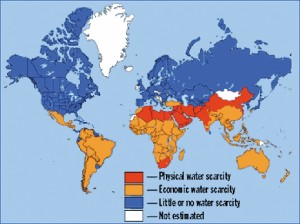Global Water Scenario
Water is the most essential resource for life. Life, be it for humans, animals or plants, cannot be conceived without water. It sustains both life and livelihood. Civilisations have risen and fallen with the rise and fall of water table.
With global population having exceeded seven billions, water is getting scarcer and scarcer. As more people stream into cities, even the little water is getting difficult to access.
People could be citizens of one or the other nation-state. But rivers are not the property of any particular state. They are part of a vast ecosystem and flow through several states. As more powerful among these states try to appropriate their waters, the weaker are bound to be deprived. Competing claims on rivers therefore lead to conflicts. Such conflicts are already aggravating relations between various states. Look at the following:
- China is reportedly building three dams on Brahmaputra (called Sangpo in Tibet) river to collect its water for irrigation in its territory. If it goes ahead with the plans, it would mean decreased availability of water all along its length in the North-eastern states of India and Bangladesh. Affected livelihoods in Bangladesh will directly lead to exodus of ecological refugees who have nowhere to go than to come to India. Any such dislocation of people will have disastrous social, economic and political consequences for the region.
- Egypt is worried over Ethiopia raising a dam over Blue Nile and has threatened it with military reprisals.
- Conflict in Darfur region of Sudan had its roots in depletion of water supply and grassland for tribals inhabiting that region.
- Israel has usurped all the water resources of the land under Palestinian Authority and put them beyond the reach of Palestinians by raising a wall all through the Palestinian territory.
Pointers to the Crisis
- Nearly a fifth of the global population lacks easy access to potable water.
- More than half of the people across the world live in water-stressed areas.
- The annual global economic losses from water shortages are conservatively estimated at $260 billion.
- Water is renewable but finite resource. Nature can only replenish only the extent of 43,000 billion cubic metres per year. This is the maximum theoretical amount of water regenerated under natural conditions. But the human population has doubled since 1970 and water use has also diversified due to lifestyle changes.
- Now more water is diverted to grow fodder for livestock which in turn supply meat. As the human dietary habits turn meat-centric, agriculture would become more water intensive.
- Production of meat is estimated to be 10 times more water-intensive than plant based calories and proteins.
- Even growing dependence on bio-fuels such as ethanol, has led to diversion of water to grow bio-fuel yielding crops such as maize etc.
- The InterAction Council comprising more than 30 former heads of states or government, has called for urgent action as nations facing water crisis may be listed under failing states.
- The US State Department has upgraded water to “A Central US foreign policy concern”.
- Most water for Food Production
Although food security has been significantly increased in the past thirty years, water withdrawals for irrigation represent 66 % of the total withdrawals and up to 90 % in arid regions, the other 34 % being used by domestic households (10 %), industry (20 %), or evaporated from reservoirs (4 %).
Total Water Availability on Earth
By modern estimates the Earth’s hydrosphere contains a huge amount of water of about 1,386 million cubic kilometres. However, 97.5% of this amount is saline water and only 2.5% fresh water. The greater portion of the fresh water (68.7%) is in the shape of ice and permanent snow cover in the Antarctic, the Arctic, and mountainous regions. Next 29.9% are fresh ground waters. Only 0.26% of the total amount of fresh waters on the Earth are concentrated in lakes, reservoirs, and river systems. They are most accessible for economic needs and very important for water ecosystems
Every year the water turnover on Earth involves 577,000 cubic km of water. It is the water that evaporates from the oceanic surface (502,800 cubic kms ) and from land (74,200 cubic kms). The same water amount falls as atmospheric precipitation (on the ocean 458,000 cubic kms and on land 119,000 cubic kms). The difference between precipitation and evaporation from land surface (119,000 – 74,200 = 44,800 cubic kms per year) represents the total runoff of Earth’s rivers (42,600 cubic kms per year), and a direct groundwater runoff to the ocean (2200 cubic kms per year). These are the principal sources of fresh water to supply life necessities and man’s economic activities.
Can the Water supply be Augmented?
What is clear from the above statistics is that the humanity has been using the same water all through the centuries. So, how could the water supply be augmented? Where should be human being look for more water? Answer lies is conservation of water sources, treat and clean the waste water and use it again, at least for cleaning and washing purposes and water-harvesting i.e., collecting the rainwater and using for human needs as well as allowing it to percolate through the ground to recharge the ground aquifers.
Most facts for this piece have been extracted from economist Brahma Chellaney’s book Water, Peace and War: Confronting the Global Water crisis, Oxford University Press.
Also referred were:
http://webworld.unesco.org/water/ihp/db/shiklomanov/index.shtml
http://webworld.unesco.org/water/ihp/db/shiklomanov/summary/html/summary.html#4.2.



COMMENTS